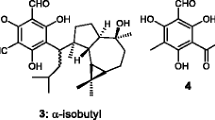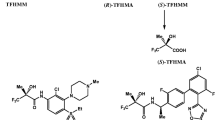Abstract
A novel amidase gene, designated pamh, was cloned from Paracoccus sp. M-1. Site-directed mutagenesis and bioinformatic analysis showed that the PamH protein belonged to the amidase signature enzyme family. PamH was expressed in Escherichia coli, purified, and characterized. The molecular mass of PamH was determined to be 52 kDa with an isoelectric point of 5.13. PamH displayed its highest enzymatic activity at 45°C and at pH 8.0 and was stable within a pH range of 5.0–10.0. The PamH enzyme exhibited amidase activity, aryl acylamidase activity, and acyl transferase activity, allowing it to function across a very broad substrate spectrum. PamH was highly active on aromatic and short-chain aliphatic amides (benzamide and propionamide), moderately active on amino acid amides, and possessed weak urease activity. Of the anilides examined, only propanil was a good substrate for PamH. For propanil, the k cat and K m were 2.8 s−1 and 158 μM, respectively, and the catalytic efficiency value (k cat/K m) was 0.018 μM−1 s−1. In addition, PamH was able to catalyze the acyl transfer reaction to hydroxylamine for both amide and anilide substrates, including acetamide, propanil, and 4-nitroacetanilide; the highest reaction rate was shown with isobutyramide. These characteristics make PamH an excellent candidate for environmental remediation and an important enzyme for the biosynthesis of novel amides.






Similar content being viewed by others
References
Asano Y, Tachibana M, Tani Y, Yamada H (1982) Purification and characterization of amidase which participates in nitrile degradation. Agric Biol Chem 46:1175–1181
Baek DH, Song JJ, Lee SG, Kwon SJ, Asano Y, Sung MH (2003) New thermostable D-methionine amidase from Brevibacillus borstelensis BCS-1 and its application for D-phenylalanine production. Enzyme Microb Technol 32:131–139
Banerjee A, Sharma R, Banerjee UC (2002) The nitrile-degrading enzymes: current status and future prospects. Appl Microbiol Biotechnol 60:33–44
Bisogno T, De Petrocellis L, Di Marzo V (2002) Fatty acid amide hydrolase, an enzyme with many bioactive substrates. Possible therapeutic implications. Curr Pharm Des 8:125–133
Carvalho G, Marques R, Lopes AR, Faria C, Noronha JP, Oehmen A, Nunes OC, Reis MAM (2010) Biological treatment of propanil and 3,4-dichloroaniline: kinetic and microbiological characterisation. Water Res 44(17):4980–4991
Chebrou H, Bigey F, Arnaud A, Galzy P (1996) Study of the amidase signature group. Biochim Biophys Acta 1298:285–293
Ciskanik L, Wilczek JM, Fallon RD (1995) Purification and characterization of an enantioselective amidase from Pseudomonas chlororaphis B23. Appl Environ Microbiol 61:998–1003
Clarke PH (1970) The aliphatic amidases of Pseudomonas aeruginosa. Adv Microb Physiol 4:179–222
d’Abusco AS, Ammendola S, Scandurra R, Politi L (2001) Molecular and biochemical characterization of the amidase from hyperthermophilic archaeon Sulfolobus solfataricus. Extremophiles 5:183–192
Fournand D, Bigey F, Aranaud A (1998) Acyl transfer activity of an amidase from Rhodococcus sp. R312: formation of a wide range of hydroxamic acids. Appl Environ Microbiol 64:2844–2852
Galadari S, Wu BX, Mao C, Roddy P, El Bawab S, Hannun YA (2006) Identification of a novel amidase motif in neutral ceramidase. Biochem J 393(Pt 3):687–695
Gopalakrishna KN, Stewart BH, Kneen MM, Andricopulo AD, Kenyon GL, McLeish MJ (2004) Mandelamide hydrolase from Pseudomonas putida: characterization of a new member of the amidase signature family. Biochemistry 43:7725–7735
Jia KZ, Cui ZL, He J, Guo P, Li SP (2006) Isolation and characterization of a denitrifying monocrotophos degrading Paracoccus sp. M-1. FEMS Microbiol Lett 263:155–162
Kim SH, Shin DH, Kim R, Adams P, Chandonia JM (2008) Structural genomics of minimal organisms: pipeline and results. Methods Mol Biol 426:475–496
Kobayashi M, Shimizu S (1998) Metalloenzyme nitrile hydratase: structure, regulation, and application to biotechnology. Nat Biotechnol 16:733–736
Kohyama E, Dohi M, Yoshimura A, Yoshida T, Nagasawa T (2007) Remaining acetamide in acetonitrile degradation using nitrile hydratase- and amidase-producing microorganisms. Appl Microbiol Biotechnol 74:829–835
Komeda H, Asano Y (2000) Gene cloning, nucleotide sequencing, and purification and characterization of the D-stereospecific amino-acid amidase from Ochrobactrum anthropi SV3. Eur J Biochem 267:2028–2035
Kotlova E, Chestukhina GG, Astaurova OB, Leonova TE, Yanenko AS, Debabov VG (1999) Isolation and primary characterization of an amidase from Rhodococcus rhodochrous. Biochemistry (Mosc) 64:384–389
Krieg L, Ansorge-Schumacher MB, Kula MR (2002) Screening for amidases: isolation and characterisation of a novel D-amidase from Variovorax paradoxus. Adv Synth Catal 344:965–973
Krieg L, Slusarczyk H, Verseck S, Kula MR (2005) Identification and characterization of a novel D-amidase gene from Variovorax paradoxus and its expression in Escherichia coli. Appl Microbiol Biotechnol 66:542–550
Ksenia E, Harald T, Stefan V, Garabed A (2004) Purification and properties of an enantioselective and thermoactive amidase from the thermophilic actinomycete Pseudonocardia thermophila. Appl Microbiol Biotechnol 65:38–45
Kwak JH, Shin K, Woo JS, Kim MK, Kim SI, Eom SH, Hong KW (2002) Expression, purification, and crystallization of glutamyl-tRNA(Gln) specific amidotransferase from Bacillus stearothermophilus. Mol Cells 14:374–381
Labahn J, Neumann S, Buldt G, Kula MR, Granzin J (2002) An alternative mechanism for amidase signature enzymes. J Mol Biol 322:1053–1064
Laemmli U (1970) Cleavage of structural proteins during the assembly of the head of bacteriophage T4. Nature 227:680–685
Makhongela HS, Glowacka AE, Agarkar VB (2007) A novel thermostable nitrilase superfamily amidase from Geobacillus pallidus showing acyl transfer activity. Appl Microbiol Biotechnol 75:801–811
Mayaux J, Cerebelaud E, Soubrier F, Faucher D, Petre D (1990) Purification, cloning, and primary structure of an enantiomer-selective amidase from Brevibacterium sp. strain R312: structural evidence for genetic coupling with nitrile hydratase. J Bacteriol 172:6764–6773
McKinney MK, Cravatt BF (2005) Structure and function of fatty acid amide hydrolase. Annu Rev Biochem 74:411–432
Miller SA, Dykes DD, Polesky HF (1988) A simple salting out procedure for extracting DNA from human nucleated cells. Nucleic Acids Res 16:1215
Neu D, Lehmann T, Elleuche S, Pollmann S (2007) Arabidopsis amidase 1, a member of the amidase signature family. FEBS J 274(13):3440–3451
Neumann S, Kula MR (2002) Gene cloning, overexpression and biochemical characterization of the peptide amidase from Stenotrophomonas maltophilia. Appl Microbiol Biotechnol 58(6):772–780
Ohtaki A, Murata K, Sato Y, Noguchi K, Miyatake H, Dohmae N, Yamada K, Yohda M, Odaka M (2010) Structure and characterization of amidase from Rhodococcus sp. N-771: insight into the molecular mechanism of substrate recognition. Biochim Biophys Acta 1804(1):184–192
Politi L, Chiancone E, Giangiacomo L, Cervoni L, d’Abusco AS, Scorsino S, Scandurra R (2009) pH-, temperature- and ion-dependent oligomerization of Sulfolobus solfataricus recombinant amidase: a study with site-specific mutants. Archaea 2:221–231
Sathesh Prabu C, Thatheyus AJ (2007) Biodegradation of acrylamide employing free and immobilized cells of Pseudomonas aeruginosa. Int Biodeter Biodegr 60:69–73
Shin S, Lee TH, Ha NC, Koo HM, Kim SY, Lee HS, Kim YS, Oh BH (2002) Structure of malonamidase E2 reveals a novel Ser-cisSer-Lys catalytic triad in a new serine hydrolase fold that is prevalent in nature. EMBO J 21:2509–2516
Sonke T, Ernste S, Tandler RF, Kaptein B, Peeters WPH, Assema FBJ, Wubbolts MG, Schoemaker HE (2005) L-Selective amidase with extremely broad substrate specificity from Ochrobactrum anthropi NCIMB 40321. Appl Environ Microbiol 71(12):7961–7973
Studier FW (2005) Protein production by auto-induction in high density shaking cultures. Protein Expr Purif 41:207–234
Valina AL, Mazumder-Shivakumar D, Bruice TC (2004) Probing the Ser-Ser-Lys catalytic triad mechanism of peptide amidase: computational studies of the ground state, transition state, and intermediate. Biochemistry 43:15657–15672
Weatherburn MW (1967) Phenol-hypochlorite reaction for determination of ammonia. Anal Chem 39:971–974
Acknowledgments
This work was supported by grants from the Chinese National Natural Science Foundation (31070099, 31000060, and 30830001), the Natural Science Foundation of Jiangsu Province, China (BK2009312), and the Key Technology R&D Program of Jiang Su Province (BE2009670).
Author information
Authors and Affiliations
Corresponding author
Rights and permissions
About this article
Cite this article
Shen, W., Chen, H., Jia, K. et al. Cloning and characterization of a novel amidase from Paracoccus sp. M-1, showing aryl acylamidase and acyl transferase activities. Appl Microbiol Biotechnol 94, 1007–1018 (2012). https://doi.org/10.1007/s00253-011-3704-6
Received:
Revised:
Accepted:
Published:
Issue Date:
DOI: https://doi.org/10.1007/s00253-011-3704-6




